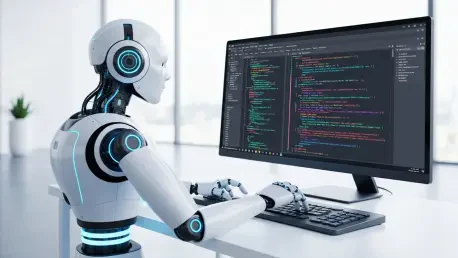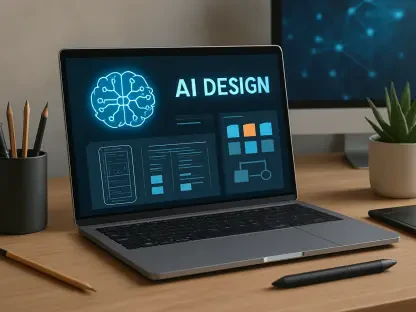The Dawn of a New Era in Coding
In an age where technology evolves at breakneck speed, artificial intelligence has emerged as a game-changer in software development, turning complex, time-consuming tasks into streamlined, intuitive processes that redefine productivity. AI-driven tools are no longer just a futuristic concept but a cornerstone of modern tech ecosystems, empowering developers to create faster, smarter, and more innovative solutions. The significance of these tools lies in their ability to automate repetitive tasks, reduce errors, and enable even non-technical users to contribute to coding projects. This analysis delves into the current landscape of AI in software development, exploring growth trends, real-world applications, expert perspectives, and the potential future of this transformative technology.
The Surge of AI in Software Development
Expanding Reach and Adoption
The adoption of AI-driven tools in software development has seen remarkable growth, with market projections indicating a robust trajectory over the coming years. According to industry reports from sources like Gartner, the global market for AI software tools is expected to expand significantly between 2025 and 2030, driven by increasing demand for efficiency in coding and project management. Surveys also reveal that a growing percentage of developers now integrate AI tools into their workflows, with many reporting up to a 40% reduction in development time.
Beyond individual developers, businesses of all sizes are embracing these technologies to stay competitive. Statistics highlight that companies utilizing AI for debugging and code optimization have cut project costs by substantial margins, sometimes by as much as 30%. This widespread reliance underscores a shift in the industry, where AI is not merely an add-on but a fundamental component of modern software creation, reshaping how timelines and budgets are managed.
Practical Uses and Breakthroughs
AI tools are actively transforming the software development landscape through innovative applications that simplify complex processes. A prime example is Lamatic.ai’s latest release, Lamatic 3.0, which introduces a feature known as “vibe coding.” This allows developers to describe their needs in natural language, with the tool autonomously generating the corresponding code, thus minimizing manual effort.
Other prominent players, such as GitHub Copilot and Tabnine, contribute by automating repetitive coding tasks and enhancing team collaboration through intelligent suggestions and error detection. These tools have become invaluable in accelerating project delivery while maintaining high-quality standards. Their ability to learn from user inputs further personalizes the development experience, catering to unique project requirements.
A notable aspect of Lamatic.ai’s approach is its tiered pricing model, which ensures accessibility for a diverse user base, from solo developers to large enterprises. With options ranging from a free plan to customizable enterprise solutions, this structure democratizes access to cutting-edge technology. Success stories of users leveraging such tools to scale their operations highlight the tangible impact of AI on fostering innovation across different levels of expertise.
Insights from Industry Leaders
The transformative power of AI in software development is echoed by key figures in the field who recognize both its potential and its challenges. Charles Whiteman, CEO of Lamatic.ai, emphasizes the importance of empowering clients through AI agent-building capabilities, enabling them to develop and maintain solutions independently. This perspective reflects a broader industry shift toward user autonomy, reducing reliance on external tech providers.
Experts also point to significant hurdles that remain, including the quest for fully autonomous systems that can operate without human oversight. Ethical considerations, such as ensuring transparency in AI decision-making, are frequently discussed alongside the need for developers to upskill and adapt to rapidly changing tools. These insights suggest that while AI offers immense benefits, its integration requires careful navigation of technical and societal implications.
Balancing optimism with caution, industry voices stress the importance of addressing data privacy concerns as AI tools become more embedded in development processes. The consensus is that ongoing dialogue and collaboration among stakeholders are essential to harnessing the technology’s advantages while mitigating risks. Such discussions are shaping the direction of AI adoption, ensuring it aligns with broader industry values.
Looking Ahead: The Evolution of AI Tools
The future of AI-driven development tools holds promise for even greater advancements, with concepts like fully autonomous systems—capable of independent decision-making—on the horizon. Innovations in this area, as seen in iterative updates from companies like Lamatic.ai, suggest that such systems could further slash development timelines, making software creation faster and more intuitive for users of all skill levels.
Potential benefits extend beyond efficiency, with AI poised to democratize coding by enabling non-technical individuals to participate in software projects through user-friendly interfaces. However, challenges such as ensuring data security and addressing fears of job displacement in traditional coding roles must be tackled. These concerns highlight the dual nature of AI’s impact, where opportunity and risk coexist in equal measure.
The broader implications of these tools span multiple industries, from healthcare to education, where AI-driven software could unlock new avenues for innovation. Optimistic outlooks envision a world where technology bridges gaps in expertise, while cautious perspectives urge vigilance against over-reliance on automated systems. This balance of hope and pragmatism will likely define the trajectory of AI in development over the coming years.
Reflecting on the Path Forward
Looking back, the journey of AI in software development reveals a dynamic shift, as tools have evolved from niche solutions to indispensable assets, evidenced by the rapid adoption rates and transformative applications like Lamatic 3.0. Expert voices provide critical guidance, highlighting both the empowering potential and the ethical complexities of this technology. The exploration of future possibilities paints a picture of innovation tempered by responsibility.
As a next step, developers and businesses should actively engage with these tools, experimenting with their capabilities to stay competitive in a fast-evolving landscape. Policymakers, too, must prioritize frameworks that address privacy and equity concerns, ensuring AI’s growth benefits society at large. By fostering collaboration and continuous learning, stakeholders can shape a future where AI enhances creativity without compromising core human values.









